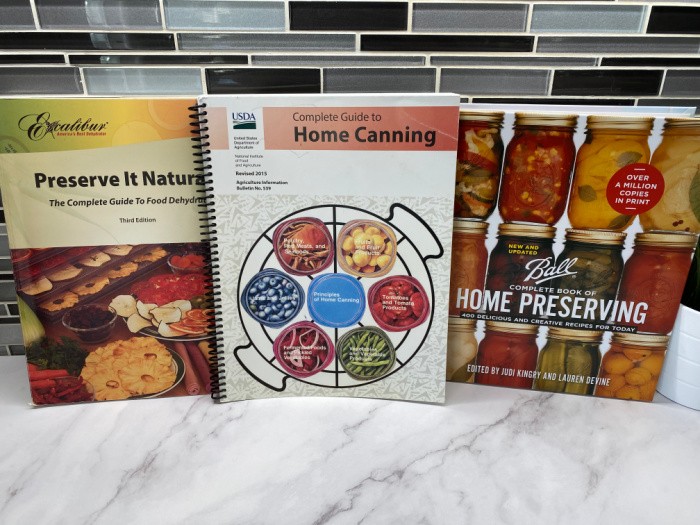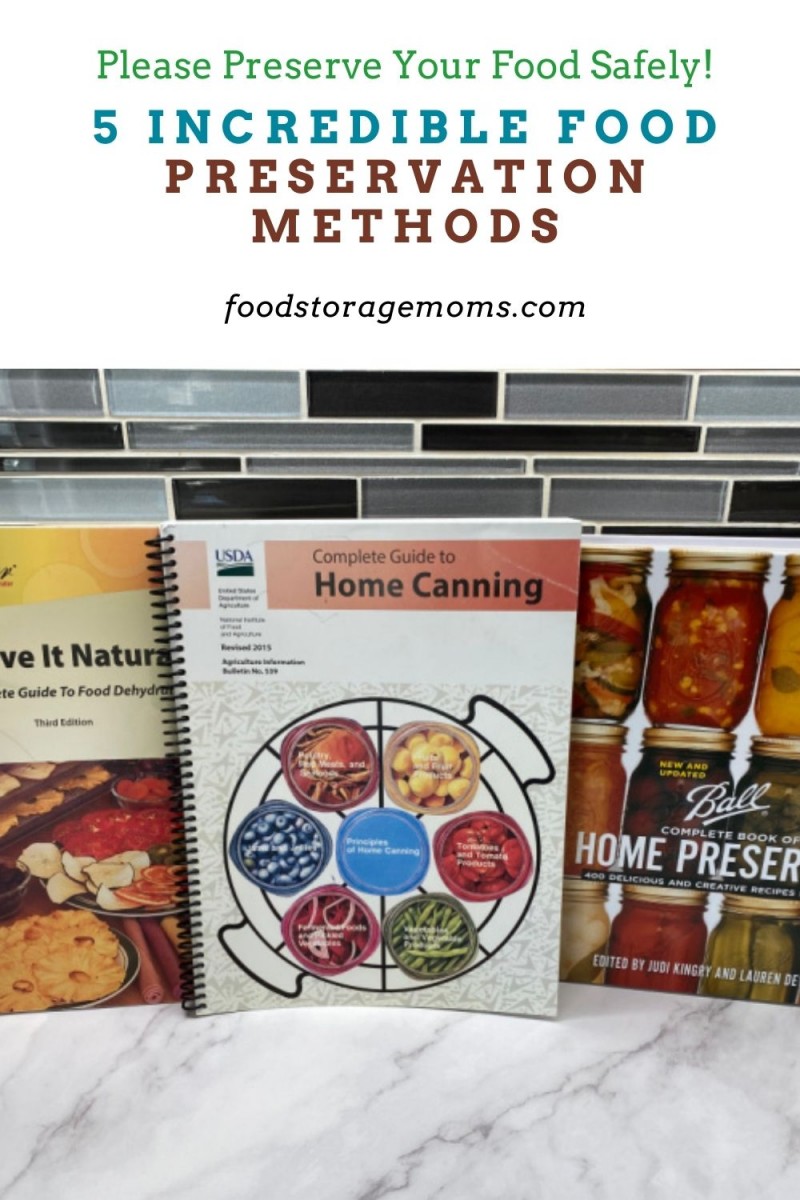
The most important aspect of our food preservation methods is choosing the right one for the job. There are many different ways to preserve food, and each has its advantages and disadvantages. The best way to choose an appropriate food preservation method is to consider what type of food you are preserving, how long you need it to last, and what type of equipment you have available.
PLEASE invest in a reputable canning book, Ball Canning Book, or USDA Canning Guidelines
Canning Items I Recommend:
- Ball Canning Book
- USDA Canning Guidelines
- Water Bath Canner
- Ball Electric Water Bath Canner
- Presto Pressure Canner
- All-American Pressure Canner (because of the weight of this pressure canner, please confirm your stovetop can handle the weight)
- Excalibur Dehydrator
- Apple Peeler/Corer/Slicer
- Funnel and Canning Items

What is Food Preservation?
Food, by nature, is perishable without intervention. Fortunately, humans have been using various methods of food preservation for thousands of years to prolong the life and safety of our food.
Food preservation is the process of treating and handling food to stop or slow down the spoiling (decaying or decomposing). Food spoilage is caused by the growth of bacteria, yeasts, and molds which can cause illness if ingested.
5 Food Preservation Methods
There are many different food preservation methods, each with its own advantages and disadvantages. Some food preservation methods are relatively new, while others date back to ancient times. Over the years, we have refined the process and better understand the mechanisms. Here are the most common food preservation methods:
Canning
Canning is a process of sealing food in airtight containers (jars or cans) and boiling them to kill any bacteria or other microorganisms that might cause spoilage. Canning is an effective way to preserve food because it prevents oxygen from reaching the food. Like most organisms, bacteria needs oxygen to grow.
Canning Process
Before you begin canning any food, read the USDA’s Complete Guide to Home Canning and my Home Canning-Important Do’s and Don’ts!
- Choose the right canning method
There are two main methods of canning: water bath canning and pressure canning. Water bath canning is best for high-acid foods like fruits and pickles, while pressure canning is necessary for low-acid foods like meat and vegetables.
- Choose the right canning equipment
You’ll need a few basic pieces of equipment to get started, including a large pot, a canning rack, and jars with lids and bands.
- Prepare your food
Canning recipes will often call for prepping the food in a certain way, such as peeling or chopping vegetables. Make sure to follow the recipe carefully to ensure that your food is properly prepared.
- Process the jars
Once your jars are filled with prepared food, it’s time to process them. This involves placing them in the canning pot and boiling them for a set period of time. Make sure to consult your recipe for specific processing times since each food product is different.
Freezing
Freezing is the process of chilling food to very low temperatures (-18°C or 0°F) in order to keep bacteria from growing. Freezing is an effective way to preserve food because it prevents bacteria from multiplying.
How to Freeze Food
Freezing is a great choice if you want to preserve leftovers or pre-made meals. It’s also great for fresh veggies from your garden.
1. Choose the right container
Freezer-safe containers are made from materials that won’t crack or shatter when exposed to extreme cold. Freezer bags and plastic wrap are also good options.
2. Label and date your containers
This will help you keep track of what you have in your freezer and ensure that you use it before it goes bad. Sometimes it’s hard to tell what is in that bag or container once it freezes.
3. Fill your containers properly
Leave some space at the top of the container so that the food has room to expand as it goes through the freezing process.
4. Don’t overfill your freezer
Freezing food can take up a lot of space, so make sure you don’t overcrowd your freezer. This will help ensure that your food stays frozen and doesn’t spoil.
Pickling
Pickling is a process of preserving food in an acidic solution, such as vinegar or brine (saltwater). Pickling is an effective way to preserve food because the acid prevents bacteria from growing.
How to Pickle Foods
Pickling is a great way to extend the shelf life of your favorite fruits and vegetables. The pickling process involves immersing the food in a vinegar or brine solution, which preserves the food and gives it a unique flavor.
- Choose your fruits and vegetables
First, choose the fruit or vegetable that you want to pickle. Asparagus, beets, bell peppers, blueberries, cauliflower, carrots, cherries, fennel, ginger, grapes, green beans, mushrooms, onions, parsnips, peaches, peppers, radishes, ramps, rhubarb, strawberries, squash, tomatoes, and turnips can all be pickled.
- Prepare your solution
Next, prepare the pickling solution, consisting of vinegar, water, salt, and spices. The basic ratio for pickles is 1:1 vinegar to water and some combination of salt and/or sugar. Another common ratio is 3:2:1. So three parts vinegar, two parts water, and one part sugar.
- Sterilize the jars
Once the pickling solution is ready, sterilize your jars and lids by boiling them in water for 10 minutes.
- Fill the jars
Then, carefully place the fruit or vegetable in the jars, making sure to pack them tightly.
- Cover with solution
Finally, pour the pickling solution over the fruit or vegetable until it is completely covered, then seal the jar with a lid. PICKLING IS FOR REFRIGERATION ONLY. Please do not put these jars on your pantry shelf. If you decide to process these jars you must follow the BALL Canning or USDA Canning Guidelines.
Drying/Dehydrating
Drying is a process of removing moisture from food, which makes it difficult for bacteria to grow. Drying is an effective way to preserve food because the lack of moisture prevents bacteria from multiplying. Dehydrating foods is a great way to create shelf-stable foods that can last for months, or even years.
How to Dehydrate Food
Fruits and vegetables are most commonly dehydrated. I’ve dehydrated apples, bananas, kale, watermelon, and Basil, to name a few.
- Choose fresh, ripe fruit or vegetables
Make sure they are free of blemishes or bruised spots. If you’re using frozen fruits or vegetables, thaw them completely before dehydrating.
- Cut the produce into uniform pieces
You want pieces that are no more than 1/2-inch thick. If the pieces are too thick, they’ll take too long to dehydrate; if they’re too thin, they may dehydrate unevenly or even burn.
- Put on dehydrator racks
Place your fruit or vegetables on the dehydrator racks, making sure that they don’t touch each other. If necessary, use multiple racks to ensure good airflow around all the pieces.
- Turn on the dehydrator
Set the dehydrator to the recommended temperature for the type of fruit or vegetable you’re drying. For most fruits and vegetables, this temperature is between 135 and 145 degrees Fahrenheit.
- Check on the produce
After the recommended drying time has passed, check the produce. If necessary, flip the pieces over and continue dehydrating until they’re completely dry.
- Store properly
Store the dried fruit or vegetables in an airtight container. For best results, use them within 6-12 months. Please remember, that they don’t have preservatives.
Fermenting
Fermenting is the process of using bacteria to preserve food. The bacteria convert the sugars in the food into lactic acid, which prevents other bacteria from growing. Fermenting is an effective way to preserve food because the lactic acid inhibits the growth of other bacteria.
How to Ferment Food
Almost any vegetable can be fermented, but if you want to ferment anything else, make sure to do your research.
- Choose your fermenting vessel
A mason jar or crock container works well.
- Pick your fermenting food.
Cabbage makes great sauerkraut, but you can also ferment carrots, beets, or other vegetables.
- Shred and chop the food
Shred or chop your food to be fermented and add it to the vessel.
- Add Salt
Add some salt. Salt helps to preserve the fermenting food and is a necessary step.
- Fill with water
Fill the vessel with water, leaving about an inch of headspace at the top.
- Cover the vessel
Cover the fermenting food with a cloth and secure it with a rubber band.
- Ferment the food
Ferment the food for about 2 weeks (leave it in the vessel), checking on it occasionally to make sure everything is going well.
- Store properly
After 2 weeks, transfer the fermented food to a new container and store it in the fridge. Fermented foods will keep for several months in the fridge!
In case you missed this post, Why You Should Stock Sauerkraut
Advantages and Disadvantages of Common Food Preservation Methods:
Each food preservation method has its own advantages and disadvantages.
- Canning-This is an effective way to preserve food, but it requires specialized equipment and can be time-consuming.
- Freezing- Freezing is easy and convenient, but it can cause freezer burn if not done correctly.
- Pickling- This is a great way to add flavor to food, but it can make food too salty for some people.
- Drying-Drying or dehydrating is a simple and effective way to preserve food, but it can take a long time depending on the moisture content of the food product and the temperature setting of your unit.
- Fermenting-This is a great way to preserve food and add flavor, but it requires special care to prevent contamination.
Final Word
There are many different ways to preserve food. The best method for you will depend on your needs and preferences. Be sure to do your research before you start preserving food so that you can choose the best method for your situation! Always use a recipe to ensure you are preserving your food correctly, that’s why I always have my preservation instruction books handy! May God Bless this world, Linda
